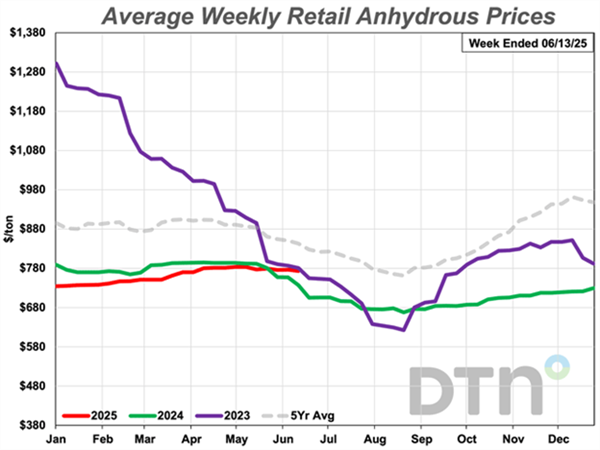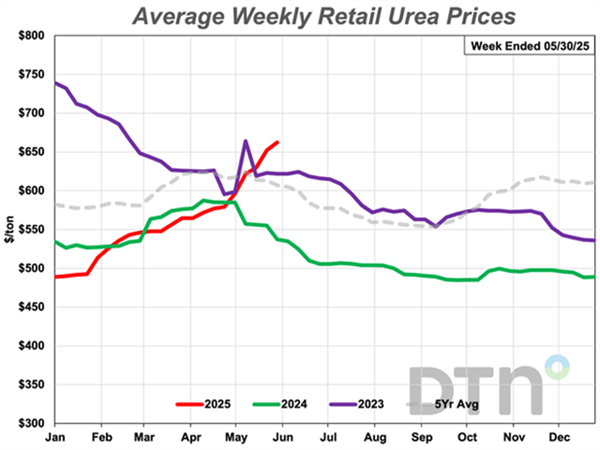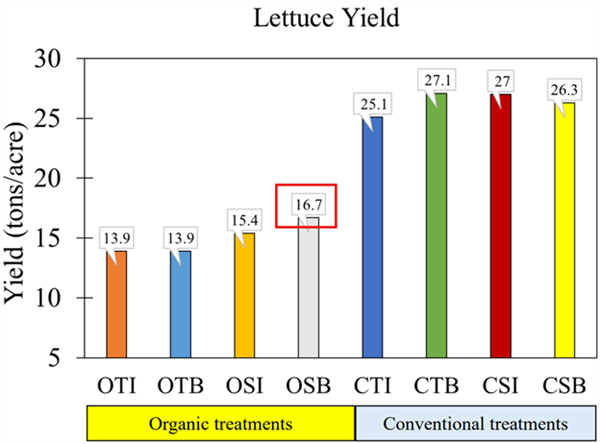Jun 25, 2025
Urea Fertilizer Price Trends
Fertilizer prices have been relatively stable in 2025 and close to 2024 prices. In the last four to six weeks fertilizer prices have been increasing. Based on recent reports, prices for seven major fertilizers are now trending higher than a year ago. Price increases compared to 2024 are shown in Table 1. Recent market prices for the same seven fertilizers are listed in Table 2.

Table 1. Percent fertilizer price increases compared to 2024. Source: Quinn, 2025b.

Table 2. Recent fertilizer prices, US$/Ton. Source: Quinn, 2025b.
Anhydrous ammonia (82% nitrogen (N)) is a common measure of the fertilizer market since most N containing fertilizers are based on anhydrous ammonia in manufacturing. Price trends for anhydrous ammonia are presented in Figure 1 comparing prices for 2023-2025 with a five-year average.

Figure 1. Average weekly retail anhydrous ammonia (82% nitrogen) prices in 2023-2025
and five-year average, US$/Ton. Source: Quinn, 2025a
One concern in the fertilizer industry currently is associated with urea (46% N), which has been steadily increasing in price over the past six months (Figure 2). These concerns have recently been exacerbated by the conflict in the Middle East that has closed urea production in Iran.

Figure 2. Average weekly retail urea fertilizer prices in 2025, US$/Ton. Source: Quinn,
2025a
In 2024, Iran was the third largest global producer of urea. Annual urea export volumes from Iran have been around 4.5 million (M)tons, which is about the same as China’s urea export production. Industry experts estimate urea production of Iran to be approximately 8.9 M tons/year. Their major international clients have included Turkey, Brazil, and Argentina. The Iranians sell urea to many other countries as well (Hanrahan, 2025).
In recent years, the United States has not been purchasing Iranian urea. But the disruption in anhydrous ammonia and urea production from a major producer such as Iran, can be expected to create disruptions in the global fertilizer market.
This happened with N fertilizers in 2022 following the Russian invasion of Ukraine, after which global N fertilizer prices rapidly increased. After about 18 months fertilizer prices stabilized (Figures 1 and 2).
With the instability and uncertainties that are currently being experienced with Middle Eastern conflicts, it is important to watch global fertilizer markets and expect some changes.
References:
Hanrahan, R. 2025.Iran-Israel Conflict Adds Uncertainty to Fertilizer Market. University ofIllinois Farm Policy News Summary, 17 June 2025. https://farmpolicynews.illinois.edu/2025/06/iran-israel-conflict-adds-uncertainty-to-fertilizer-market/
Quinn, R. 2025a. DTNRetail Fertilizer Trends: Urea, UAN28 Lead Major Fertilizer Prices Higher.Progressive Farmer, DTN. 4 June 2025.
Quinn, R. 2025b. DTNRetail Fertilizer Trends: All Retail Fertilizers See Only Slight Price Movesfor First Time This Spring. Progressive Farmer, DTN. 18 June 2025. https://www.dtnpf.com/agriculture/web/ag/crops/article/2025/06/18/retail-fertilizers-see-slight-price















